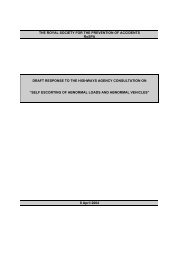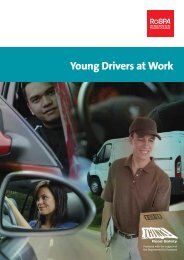RoSPA Drinking and Driving Policy Paper 2007
RoSPA Drinking and Driving Policy Paper 2007
RoSPA Drinking and Driving Policy Paper 2007
You also want an ePaper? Increase the reach of your titles
YUMPU automatically turns print PDFs into web optimized ePapers that Google loves.
The Royal Society for the Prevention of Accidents<br />
<strong>Drinking</strong> <strong>and</strong> <strong>Driving</strong> <strong>Policy</strong> <strong>Paper</strong><br />
Updated May <strong>2007</strong><br />
The proportion claiming to "leave the car at home" when going drinking has increased<br />
from 54% to 79%, <strong>and</strong> the proportion claiming to avoid the risk by "arranging for<br />
someone else to drive" has increased from 48% to 67%. There has also been a<br />
marked reduction in the belief that it is difficult to avoid drinking <strong>and</strong> driving (from 61%<br />
down to 19% in 1997) <strong>and</strong> that knowing you will have to drive spoils the evening (from<br />
64% to 46%).<br />
The percentage of male drivers at risk who disagreed strongly that "Having one or two<br />
drinks does not really make me more likely to have an accident", increased by 7<br />
percentage points among drivers in December 1998 <strong>and</strong> remained level in January<br />
1999.<br />
In November 1998, 29% of male drivers strongly agreed that even one drink made<br />
them a worse driver <strong>and</strong> at the start of the campaign in December this had increased<br />
by seven percentage points to 36%.<br />
However, there is still much to do to increase public knowledge <strong>and</strong> awareness. A<br />
survey in January 2001 found that only 13% of drivers could correctly state the legal<br />
alcohol limit, a quarter of motorists thought it was half the correct figure <strong>and</strong> 48%<br />
simply did not know. The survey also found that 56% of drivers admitted to driving<br />
‘after a drink or two’ but remaining below the limit, 3% of drivers agreed that they did<br />
so frequently.<br />
Publicity <strong>and</strong> advertising should continue to encourage a climate that drinking <strong>and</strong><br />
driving is socially unacceptable <strong>and</strong> be aimed at encouraging friends <strong>and</strong> relatives to<br />
influence the behaviour of potential or existing offenders. Although the incidence of<br />
drinking <strong>and</strong> driving has dropped dramatically over the years the issue needs to be<br />
kept in the public arena so that people don't become complacent. Young, male drivers<br />
particularly need a constant reminder about the dangers of drinking <strong>and</strong> driving, as<br />
they are over-represented in drink drive accidents.<br />
There can be little doubt that the national publicity campaigns run by the Government<br />
over the last two decades are one of the reasons that public attitudes to drink driving<br />
have improved. It is essential that they are continued <strong>and</strong> are evaluated to enable<br />
future campaigns to be appropriately designed <strong>and</strong> targeted. The ultimate message<br />
behind any publicity should be ‘do not drink <strong>and</strong> drive – there is no safe limit’.<br />
The advertising strategy should include the tragic consequences of drink drive<br />
crashes, have a high emotional impact <strong>and</strong> confront the potential drink driver. More<br />
information to learner drivers on the consequences of drink driving would be helpful<br />
along with increased editorial for road deaths in general. More messages could be<br />
incorporated on TV via soaps, <strong>and</strong> pubs could be encouraged to display lively<br />
materials. Free time should be given to campaigns by the BBC.<br />
It is important to provide more education on alcohol <strong>and</strong> drinking <strong>and</strong> driving for young<br />
people <strong>and</strong> learner drivers in particular. Initial input should be to school children <strong>and</strong><br />
exp<strong>and</strong>ed during driver training. Materials should be used within the national<br />
curriculum or as leaflets to parents. Efforts should be made to encourage first time,<br />
low level offenders to attend alcohol education programmes to help solve any drinking<br />
problems they may have. More contact should be made with health professionals, for<br />
example, by linking the HRO scheme to hospitals <strong>and</strong> offering rehabilitation where<br />
necessary.<br />
16
















